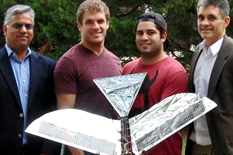
|
 |
The Robo Raven III team (L-R) S.K. Gupta, Luke Roberts, Ariel Perez-Rosado and Hugh Bruck. |
|
Professors S.K. Gupta (ME/ISR) and Hugh Bruck (ME) and their students in the Maryland Robotics Center have developed and demonstrated a new version of the Robo Raven micro air vehicle (MAV) that incorporates solar panels in its wings.
While the solar panels don't produce enough energy to power Robo Raven III in flight (they produce around 3.6 Watts while Robo Raven needs around 30 Watts to fly), they are effective in charging the MAV's batteries when it is stationary.
In his blog, Gupta notes that the development team envisions Robo Raven flying "far away from civilizations" during long missions and needing "a way to 'feed' itself" on its journeys.
Because Robo Raven's large wings have enough surface area to create a usable amount of solar energy, the team decided to incorporate flexible solar cells into them. The captured solar energy is then used to supply Robo Raven's onboard batteries. "These new multi-functional wings will shape the future of robotic birds by enabling them to fly longer, farther, and more independently because they will be getting their power from the sun" says ME Ph.D. student Luke Roberts, a member of the Robo Raven team.
The underlying material of the flexible solar panels is different from that used in the previous version of Robo Raven. That meant the team needed to design new wings and develop a new additive manufacturing process to fabricate them, Gupta says.
"We still need to make significant improvements in solar cell efficiency and battery energy density to replicate the endurance of real ravens in Robo Raven III," Gupta says, "but the good news is that Robo Raven III has already demonstrated we can fly with a solar cell and battery combination. Now that we've successfully taken this step, swapping new technologies that are more efficient should be relatively simple."
Gupta has been working on flapping-wing robotic birds for the better part of a decade. His team first successfully demonstrated a flapping-wing bird in 2007. This spring the group introduced Robo Raven, the first flapping-wing MAV with independently flapping, programmable wings.
| Read Dr. Gupta's blog post | Watch Robo Raven III and other exciting robots on the Maryland Robotics Center's YouTube channel |
---Story by Jennifer Figgins Rooks and Rebecca Copeland
Related Articles:
Robo Raven flies live on Fox 5 TV
Khaligh, McCluskey to lead new $2.37M DOE solar power converter project
Bio-inspired robots storm local library
Robo Raven appears on 60 Minutes
ISR faculty leading bio-inspired robotics and transportation electrification REUs
Applications now being accepted for summer 2017 bioinspired robotics REU program
Visionary choreographer Huang Yi performs at Maryland, visits Robot Realization Lab
What an upgrade!
Alum Sagar Chowdhury wins ASME CIE Best Dissertation Award
New AFOSR NIFTI Center features eight Clark School faculty
September 30, 2013
|

